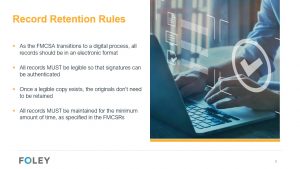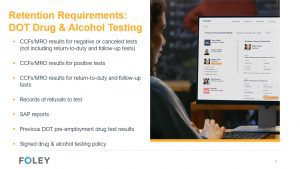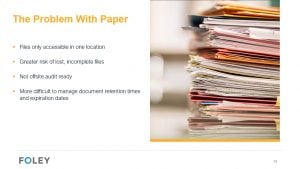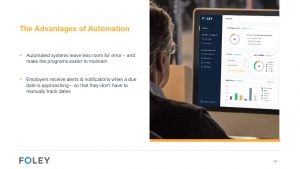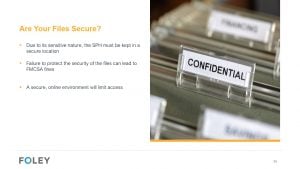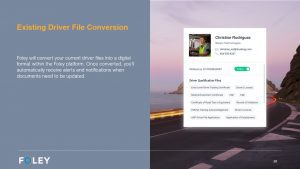Manage the Shift in DOT Recordkeeping: Webinar Transcript

Below is a full transcription of our popular webinar on DOT Recordkeeping compliance and tips called “Manage the Shift in DOT Recordkeeping.”
Hi everybody.
We will be getting started with our webinar here shortly, dealing with DOT recordkeeping changes.
We have some folks that are still dialing in, so we’ll wait a couple of minutes, and then we’ll get started.
Again, I wanted to welcome you to Foley’s webinar on Managing the Shift in DOT Recordkeeping. Throughout the course of this webinar, we’ll go over some of the modernizations that the FMCSA has begun with regard to driver compliance and driver recordkeeping.
My name is Steven Harz. I looked at the folks that were dialing in. I know a bunch of you, so that’s great, welcome. And for those of you who I have not met yet, hopefully I will at some point in time. But welcome to everybody and hopefully you find today’s talk to be helpful because there are a lot of changes that have been made recently and over the last couple of years that some folks still aren’t too aware of, so we’ll get a chance to talk about this.
Here on the screen, we have a fact: most DOT audit violations can be prevented by managing paperwork effectively.
It’s very true.
Many of the items that we’ll see on the next few slides are common knowledge. But what I’ll try to do is point out some of the things that we still see that are causing people issues and highlight the things specifically that are being problematic. As far as the basics with regard to recordkeeping within the FMCSA constraints, as we all know, businesses have to maintain their records. A lot of this information contains personal information for your employees, so it has to be held in a secure fashion. And obviously with online cybersecurity, that’s a big part of all of this.
On top of it, in today’s new digital or offsite audit climate, a lot of times the information has to be turned over to an auditor within 48 hours. So, we’ll expand on that a little bit as we go through the rest of the talk today.
Record Retention Rules
I referenced it before: the FMCSA has transitioned to a digital process for all records, so driver qualification files will have to be electronic. Some of the things that we’ll get into today are the fact that these files have to be legible because a lot of times folks will say, “Hey, I scanned in a document.” Well, if the auditor can’t read it, it doesn’t count, so legibility is very important. And as we know too, the files have to be maintained for a specific period of time and then you can get rid of them.
Retention Requirements: Driver Qualification Files
With regard to driver qualification files, there are a couple of things that I wanted to touch upon on this slide, specifically: the application itself, the job application, and then the safety performance history, or prior employment verification. With regard to the application, this is something that an auditor will now be very specific with. Applications have to be DOT compliant, and that might seem like that’s a no brainer, but it’s not. Many of the people that my colleagues and I at Foley speak to every week have more of a generic job application, but that’s not going to be a compliant solution. It has to be a DOT regulated.
And then the other piece of the puzzle with regard to the application is that it has to be filled out in its entirety. So we see a lot of instances, especially when applications have been filled out by hand where the application isn’t filled out completely, this too creates a situation where the driver file is rendered noncompliant. The other thing on this slide that I wanted to touch upon was the safety performance history. Obviously, this can be the bane of everyone’s existence. I think collectively in my time here at Foley, this has been the thing that folks have said is the biggest pain in their neck to do. Because of that, I think folks are not very diligent in doing it.
I think at one point we were told that the success rate of having a past employer respond is about a little over 20% of the time. That’s also a failing grade at audit time, so we would encourage you to be far more diligent in reaching out to past employers. Obviously, the DOT Clearinghouse takes care of some of this, but it does not take care of all of it. So, this is something that needs to be done and this information is sensitive personal information, so it has to be handled and kept in a secure fashion.
Retention Requirements: DOT Drug & Alcohol Testing
With regard to drug and alcohol testing, again, this is a lot of the nuts and bolts of compliance that everyone deals with every day. If I had to point out one thing on this slide that I would focus on, it’s actually the last bullet and it has to do with the drug and alcohol testing policy.
We see a lot of companies that have a policy, their employees have signed it, but it’s very much out of date. Probably the best example of this was the Clearinghouse. When the DOT Clearinghouse came into existence for CDL employees, they were either supposed to receive an updated policy or at least an addendum that they could sign because the Clearinghouse does represent a change in the policy. So you have to let the employees know that this is the case and they have to sign off on it saying, “Yeah, I get it.” So I think with regard to the information on this slide, a lot of it is just stuff that we’re working with every day. It’s just a matter of course, but I think that’s the one thing that I would point out that would need to have extra attention paid to it. You need to update that policy and make sure your employees have signed off on it. And then you must have that readily available in an electronic format.
You know, also having to do with drug and alcohol testing; I think on this slide the thing that I would point out has to do with random testing. We find a lot of times, and it’s not everybody, but it’s important enough to bring up. A lot of times randoms are being pulled with a list of drivers that is not current. There are new drivers to the organization that have not been added into the pool. There are drivers that have left the organization who’ve not been pulled from the pool. So obviously, this negates the validity of the selection. You certainly don’t want to be hit with something like that at the time of the audit. And then on top of it, all of this information too, needs to be kept in a secure electronic repository.
Retention Requirement: DOT Clearinghouse
Next up is the Clearinghouse. It’s been top of a lot of folks’ minds for almost the last two years…I can’t believe it’s been that long. We’ve been talking about it here for about two years in preparation for putting together our service for this. But I think again, a lot of this is a part of the recordkeeping and a lot of it has to be done electronically.
A lot of it has to be kept in a secure repository.
You need to have the consent forms completed before you can run an annual query. You have to keep a record of the queries.
The recordkeeping aspect is very important: the who, what, where, when, how and why of all of this. You can’t just run a query and be done with it, you have to keep track of what you did, when you did it, and what you found out. So these are all things, and I think just in my personal experience, that’s the biggest thing that’s tripping people up from a compliance standpoint. The consent forms, recordkeeping, and reporting violations to the Clearinghouse…these are all things that need to be done if you’re looking to pass an audit, obviously.
Other Requirements
A few other things that kind of didn’t fall into any of those categories that do need to be included in your recordkeeping for driver compliance are things like hours of service, (when applicable, obviously it doesn’t apply to everybody, but for those who do, that needs to be kept track of), proof of insurance, repair, maintenance, inspection records, and then driver training too also needs to be kept track of.
Why Paperwork Management Matters
Now we’re going to get into some of the things with regard to specifics of the paperwork, what happens when it doesn’t occur and, and that type of thing. And I would like to point out too, if you do have any questions fire away in the chat, happy to field any. Usually when I do these, I can get to a few of them. At the end of the presentation, there’ll be a phone number. If you have any questions you can call it. You all received an email to register for this webinar, you can respond to that email with questions as well, but I’ll try to get to a couple of them at the end of the session, if you do have any, so fire away in the chat if you do.
Why paperwork management matters? A lot of this, as we said in the beginning of the talk, can lead to audit failure. The paperwork and recordkeeping is the biggest reason companies are failing audits these days. Failing an audit can lead to fines, as you see here, of up to $5,000. That’s per violation, that’s not per audit, that’s per violation. Your DOT number can be deactivated, company can be put out of service, and then obviously, you might have to go through the dreaded corrective action plan, which is no one’s favorite thing to do. We do them for a lot of companies and it is not a pleasant experience. So certainly, a lot of good reasons to stay on top of your paperwork with regards to driver compliance.
How Are You Managing Driver Files?
So managing driver qualification files; there’s a lot of different ways to do it. As you can see here on this pie chart, we find that 62% of the time companies have paper driver files – either in total or in part. We’ll get into offsite audits a little bit more here as we go through the talk. But in this day and age, where just about every audit is being done remotely, obviously paper driver files are not going to cut it. You can’t transmit them, they’re oftentimes out of date, so this is something that if you do have paper files, you would want to be able to update those to a digital process as quickly as you can.
The second largest chunk in this pie tells us that 18% of companies have scanned files. A lot of times in conversations that we’ll have with companies, when they think of offsite audits, they just think of digital files, electronic files. So, “Hey, I took my paper files and I scanned them, so I’m great.”
No, you’re not, not always.
The issue, the other side of that same coin, is the fact that during an audit (and as I referenced earlier) offsite audits can be far more stringent. I spoke to a gentleman a few weeks ago and I said stringent, he said “nitpicky,” I go, “Well, that’s your word, I’m trying to be professional.”
But either way, there are a lot of things that an auditor is going to look at with the files. If they’re illegible, it’s not going to work. If they’re incomplete, like I said, with the application, if that’s incomplete, it’s not going to work. If the application’s not compliant, it’s not going to work. If med cards and licenses are out of date, you’re going to fail.
The digitization of the files is just part of the process. The other flip side of that coin is making sure that the files are completely legible, accurate, and up-to-date. So all things as we had seen on a few of the slides so far are leading to companies failing audits and things that you would need to address if you fall into this category.
Other Problem With Paper
Other problems with paper recordkeeping. Certainly one is that the files are only accessible in one location. A lot of companies that I work with have multiple locations, so it’s an issue. Obviously, if it’s in some type of online repository, anyone can have access, so you can work or update or do anything with your files from any access point.
And as we know, a little over a year ago, a lot of us were sent home to work. And I had many, many conversations with folks that said, “Hey, I can’t update my files. I can’t create a file for a new driver because I’m at home. The office is 30 minutes away. I’m not allowed to go there, so I can’t keep my files up-to-date.”
So obviously, having some sort of electronic repository is very helpful in this type of situation. It will allow your files to be ready for an offsite audit, which again is the way almost all audits are being done now. And two, with an online process, you’re able to keep track of expiration dates and make sure everything is updated and uploaded into the electronic repository.
The Current Crisis
Certainly, we’re still in, hopefully what is the tail end of the COVID situation, which has impacted almost all of us – if not all of us – tremendously in the last 12+ months. I referenced before that a lot of folks who have driver compliance-related positions are working remotely. If it is digital, you can access it from anywhere. And again, it just simplifies the overall process of maintaining files on an ongoing basis.
Preparing for Offsite Audits
A minute or so ago, I referenced offsite audits. I think the big takeaway that probably everybody is seeing right now is offsite audits are up 400% this year. Again, almost every audit is being done in this fashion. When called for an offsite audit, the lead time – we’ll talk about this in a little bit too. The lead time oftentimes is just 48 hours, whereas in the past it used to be up to a month lead time, so you had some time to do a little cleanup if you will. Now it’s very important to make sure files are audit ready at all times. You really don’t have a lot of time to play catch up.
So certainly, if you got called today and your audit was in two days, you’re going to be up against the clock, and again, on this slide, same thing. The old-fashioned way of a couple of years ago, you could get notified today and the audit would be in three or four weeks, and now it can be – it’s not always 48 hours, but a lot of the times it is. So not a lot of time, again, to play catch-up.
Offsite Audit = Paper Free
With an offsite audit, as we’ve referenced, information has to be submitted electronically. It’s done through a secure link. You certainly don’t want to expose any personal information of your employees, so a secure link is utilized. And again, as we’ve said a couple of times, you only have a 48-hour lead time for these audits. And again, because this style of remote audit can happen at any time, you really need to have a system that is going to keep your files audit ready at any time. Going digital is the way to do that.
Not All Digital Files Are Created Equally
We referenced this earlier. I liked the title here, “Not all digital files are created equally.” Again to reiterate, scanned files might be great if the file itself is in good shape. But is it up to date, is it legible? If the answer is “no,” then that’s going to be a problem at the audit. So again, do not buy into the thought that as long as your files are electronic that you’re okay – it’s the old computer adage or model of garbage in, garbage out. You want to make sure that when you’re submitting a file electronically, it is a compliant file, or you’re just looking for an issue.
The Benefits of Going Online
Some of the benefits of doing this online, certainly, is that a lot of security measures can be taken to protect information, and a lot of the process can be automated. I’ll spend some time towards the end of the talk for a minute, just to kind of go through some of the things that we do, but one of those is automating the process for updating the files, med cards, licenses, what have you. So obviously, if you’ve got a paper file sitting in a file cabinet locked in the corner of the office, you don’t have that type of process in place.
Tracking Due Dates
Again, you want to be able to track these due dates. You want to be able to give drivers ample time to get a med card or get a driver’s license renewed. Obviously you don’t want to just spring it on them. You want to give them ample time to do that.
The Advantage of Automation
I like this part of the presentation, the advantages of automation, because I deal with it a lot in my role here at Foley. When you look at that first bullet point: leaving less room for error and make the programs easier to maintain. I work with a lot of companies that have multiple geographic locations. And in most cases, there is a person or persons at each of these locations that is responsible for driver compliance. And you might have a situation where, hey, I’ve got a dozen locations and 11 of them are doing a great job, but the folks in one location aren’t paying attention, they’ve got better things to do, their part of the process is not compliant, things have fallen through the cracks, and they’re going to pull us down if we’re audited.
So you want to have an online system because a lot of times that’s going to – I hesitate to use the word “force,” – but kind of force people into doing things the right way. It’s a crutch to make sure things run smoothly and nothing falls through the cracks. So, that’s one of the advantages of doing things in an automated fashion.
Managing Additional Recordkeeping Requirements
There are other recordkeeping issues, obviously…Clearinghouse records need to be kept track of, so an automated system is going to do that. Some of them, or many of the items relating to the Clearinghouse, are required to be electronic, almost all of it. So you really can’t have too much of the Clearinghouse process on paper as it’s required that it is digital. So having a process that’s able to do that as well, is imperative.
Are Your Files Secure?
Information security – we touched upon that. A lot of this information is personal to the driver or to the applicant or the employee. And you can be fined for taking lack of proper security measures. This slide specifically talks about the Safety Performance History. This is a background check and it has to be kept secure. There’s information in there that is of sensitive nature, so we really have to make sure that when you’re housing, your files, especially in a digital format, that there is proper security measures put into place.
So that is a pretty good, I hope, overview of what’s expected from an automation or digitization standpoint. As I said a couple of minutes ago, if you grant me a minute, I’ll go through some of the things that Foley’s platform and processes are able to accomplish.
Online File Management
Obviously managing driver files in an online format is a big part of what we’re doing for folks every day. We can take current files, whether they are scanned, electronic or whether they are paper, and convert them onto our platform. And in addition to that, build new files from scratch for new drivers that are entering your organization. So we’re able to create files that when the point of time comes, and you’re called for an offsite audit, and you’ve only got two days to get things together, you don’t have to worry about it. So, we’ll have everything in place and you’ll be able to transfer the files electronically and securely to the auditor.
Alerts.
We do provide ample time for a driver to know that their license or med card is expiring, get it renewed and get it uploaded into our platform. And also, we’re able to set up an ongoing motor vehicle report monitoring, obviously not something that’s required by the DOT, but we’re finding that it is gaining in popularity all the time. A lot of companies in the last 12 to 18 months, especially, have come to us for ongoing monitoring where we’re notified anytime there’s a change in the status of someone’s driver’s licenses, and obviously we receive alerts on those things as well.
Existing Driver File Conversion
Existing Driver File Conversion, I mentioned it a few minutes ago. We are able to take a company’s current files; they might be on another platform, they might’ve been scanned in on a desktop in the office, or again, they might just be paper. But take them, convert them onto our platform, set up those alerts, and then we work on making sure that the files are audit ready at all times, so that when the day comes that you are notified for an offsite audit, you’re already in good shape and you don’t have a lot of catch-up to do.
Have Questions? (860) 815-0764
I mentioned, if you do have questions this phone number can be called. The email that was used to set you up for this webinar can be responded to, if you do have questions. We have a couple of them in the chat area, so I’ll hit a few of them. And then again, any questions that you call us or email us with, we’ll certainly turn those around as quickly as we can. And I believe too, you’ll probably get a link to a recording of this session. So if you wanted to listen to any parts of it or all of it again, you’ll be able to do that or share it with colleagues or what have you.
So we have a question, it says, “Can the FMCSA really only give you 48 hours?” I assume that’s referring to notification for an audit. Yes, they can, and yes, they do. This practice started a few years ago when they were just kind of piloting the program. So no, that’s a real thing, and it happens most of the time. As I said during the talk, it doesn’t happen all the time, but most of the time it’s going to be a two-day turnaround. So yeah, they can do that and they do do it. “Can you explain the application stuff again?” I hope I’m getting it right, I assume that that’s having to do with the job application and the compliance of that. So, if I am getting that right, and I think I am. The application has to be DOT compliant. There are certain things that the DOT needs to see in the application, and a generic application won’t cut it.
One thing that I didn’t mention in the presentation, but I’ll bring it up now while we’re on the application…it also has to be compliant with Fair Credit Reporting Act laws. So, we see things in applications like Ban the Box language, if you will. It’s asking somebody if they’ve been convicted of a felony in the past. We see release of liability language, which is usually a sentence or two along the lines of, “I hereby authorize any past employer, reference, school, whoever to speak to this prospective new employer. And I released them from liability for anything bad that they say about me that keeps me from getting this job.” It’s not all – that’s paraphrasing – but you get the point. These are things you can’t have on an online job application.
The other thing, as I mentioned too, is for the driver file to be compliant, technically, the application has to be filled out completely. In our process, when you fill out the application, the applicant can’t submit it unless it’s filled out completely. So if it’s not, they’ll be redirected back to complete the spots that they have left blank, and once it’s completed, then they’ll be able to submit it. So, hopefully that answered that question.
We’ll get to one more. We kind of touched upon it, but there’s a couple of questions here, so I’ll just go over it real quickly again. “Can I send scanned files for an offsite audit?” Yes, you can. From a format perspective, the DOT hasn’t stated that there’s any specific format. Maybe they get to it at some point in time, I don’t know, but there’s not any specific format. So a scanned file is fine, but as I said, a couple of times during the presentation, you have to make sure that the file is complete, it’s compliant, it’s legible, it’s up to date. Again, you want to avoid that garbage in/garbage out type of situation. But yes, scanned is fine as long as the file is going to pass muster.
So just for the interest of time, we’ll kind of leave it with that. Again, call us or email us with any other questions that you may have. And other than that, I really appreciate you listening in today. There are a lot of folks that have participated in many of our other webinars, and please look out for future ones that we do. Again, we try to do them every month or two. And I think if you’ve listened to this, you’ll probably be on some type of notification for future sessions so hopefully we’ll be able to talk again soon. But other than that, again, I thank you for your time and I hope you have a good rest of the day.
Thanks.
Related Articles
Webinar Transcript: Recordkeeping Secrets for Your Drug & Alcohol Testing Program
Webinar Transcript: Ask The Experts: Clearinghouse Recordkeeping & Data Management
Webinar Transcript: What to Know About Recent Drug Testing Delays
.png)






